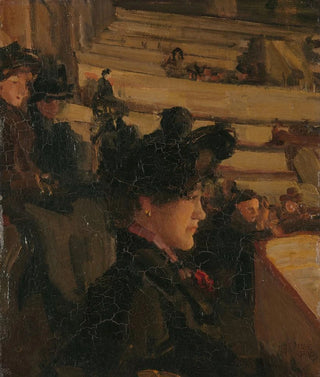Art print | At the theater - Isaac Israëls


View from behind

Frame (optional)
In the vibrant universe of art, some works manage to capture the very essence of human emotion. "Theatre - Isaac Israëls" unquestionably falls into this category. This canvas, imbued with life and dynamism, immerses us in the lively atmosphere of a theater, a place of encounters, passions, and dramas. The characters, frozen in expressive gestures, seem to come alive before our eyes, inviting us to share a moment of intimacy at the heart of their world. The piece evokes not only the magic of the spectacle but also the depth of human relationships, making each glance at the artwork a unique and personal experience.
Style and uniqueness of the work
Isaac Israëls' style is distinguished by his bold approach to light and movement. In "Theatre," he succeeds in capturing the sparkle of costumes and the richness of emotions emanating from each character. The brushstrokes, both lively and delicate, create a dynamic that transcends mere representation. The use of color, subtle and nuanced, highlights the contrasts between shadow and light, thus emphasizing the intensity of the depicted scenes. Israëls manages to bring his subjects to life, making each figure almost tangible. This realism, combined with a touch of impressionism, gives the artwork a timeless dimension, allowing the viewer to immerse themselves effortlessly.
The artist and his influence
Isaac Israëls, an emblematic figure of Dutch painting in the early 20th century, made his mark with an innovative artistic vision. Influenced by the great masters of the past, he nevertheless developed a personal style, making him a pioneer in portrait art and everyday life. His work, often focused on scenes of urban life, reveals a unique sensitivity to the beauty of fleeting moments. Israëls was also a keen observer of the customs of his time, which enabled him to capture authentic moments of life, imbued with truth. His legacy endures, inspiring many contemporary artists who seek to explore the relationship between man and his environment with

Matte finish

View from behind

Frame (optional)
In the vibrant universe of art, some works manage to capture the very essence of human emotion. "Theatre - Isaac Israëls" unquestionably falls into this category. This canvas, imbued with life and dynamism, immerses us in the lively atmosphere of a theater, a place of encounters, passions, and dramas. The characters, frozen in expressive gestures, seem to come alive before our eyes, inviting us to share a moment of intimacy at the heart of their world. The piece evokes not only the magic of the spectacle but also the depth of human relationships, making each glance at the artwork a unique and personal experience.
Style and uniqueness of the work
Isaac Israëls' style is distinguished by his bold approach to light and movement. In "Theatre," he succeeds in capturing the sparkle of costumes and the richness of emotions emanating from each character. The brushstrokes, both lively and delicate, create a dynamic that transcends mere representation. The use of color, subtle and nuanced, highlights the contrasts between shadow and light, thus emphasizing the intensity of the depicted scenes. Israëls manages to bring his subjects to life, making each figure almost tangible. This realism, combined with a touch of impressionism, gives the artwork a timeless dimension, allowing the viewer to immerse themselves effortlessly.
The artist and his influence
Isaac Israëls, an emblematic figure of Dutch painting in the early 20th century, made his mark with an innovative artistic vision. Influenced by the great masters of the past, he nevertheless developed a personal style, making him a pioneer in portrait art and everyday life. His work, often focused on scenes of urban life, reveals a unique sensitivity to the beauty of fleeting moments. Israëls was also a keen observer of the customs of his time, which enabled him to capture authentic moments of life, imbued with truth. His legacy endures, inspiring many contemporary artists who seek to explore the relationship between man and his environment with






